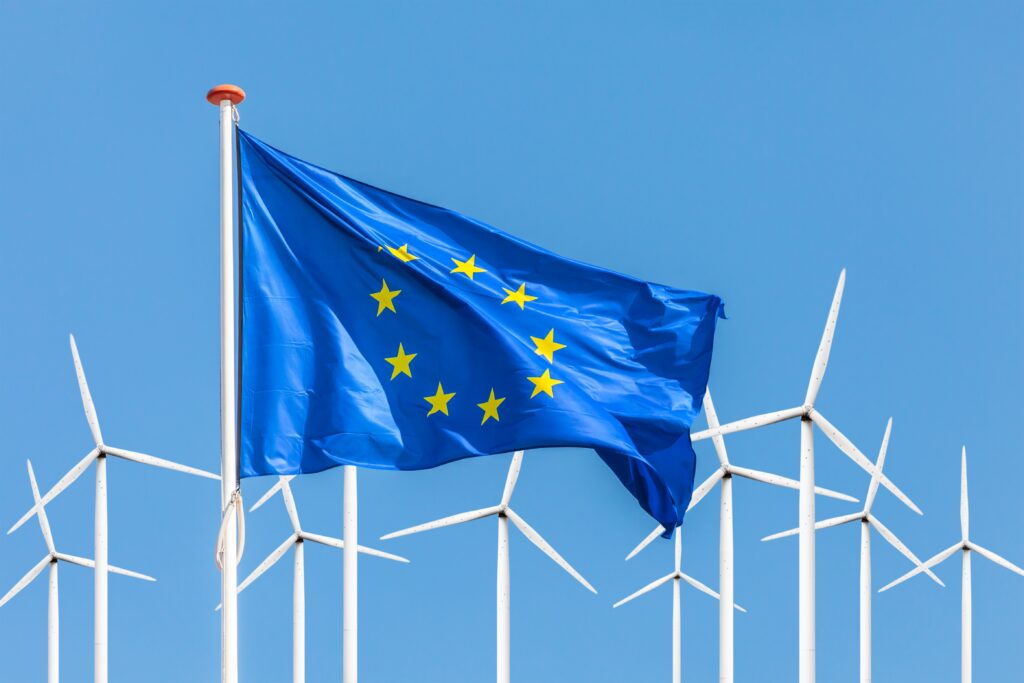Is the EU still transitioning to renewable energy?
April 29, 2025
The EU promised a renewable energy future – but is it still on track? As political shifts, policy delays and legal battles unfold, the energy transition faces new hurdles. Are we still moving forward, or is Europe starting to backpedal? Seden Anlar reports.
 Once upon a time – 2019, to be exact – the European Green Deal was the golden child of EU policy. Politicians across the spectrum embraced it with enthusiasm, promising a continent powered by renewables and free from climate-wrecking emissions by 2050. Fast forward five years and that green glow has started to fade. Russia’s full-scale invasion of Ukraine in 2022 threw energy markets into chaos, exposing the bloc’s dependence on fossil fuels. The subsequent scramble for energy security did accelerate some aspects of the energy transition, but it also shifted the EU’s focus toward immediate economic and defence concerns. Then came the political earthquake of 2024: an unprecedented surge of far-right and conservative parties swept into power, many of them itching to tear up environmental regulations in favour of ‘competitiveness’ and ‘deregulation’.
Once upon a time – 2019, to be exact – the European Green Deal was the golden child of EU policy. Politicians across the spectrum embraced it with enthusiasm, promising a continent powered by renewables and free from climate-wrecking emissions by 2050. Fast forward five years and that green glow has started to fade. Russia’s full-scale invasion of Ukraine in 2022 threw energy markets into chaos, exposing the bloc’s dependence on fossil fuels. The subsequent scramble for energy security did accelerate some aspects of the energy transition, but it also shifted the EU’s focus toward immediate economic and defence concerns. Then came the political earthquake of 2024: an unprecedented surge of far-right and conservative parties swept into power, many of them itching to tear up environmental regulations in favour of ‘competitiveness’ and ‘deregulation’.
This shifting political landscape has already translated into action. The EU recently delayed its landmark Deforestation Regulation following industry pushback, while the far-right European Conservatives and Reformists and the newly formed Patriots for Europe group have signalled their intent to weaken or dismantle key elements of the European Green Deal. With growing political opposition, the future of Europe’s clean energy transition is increasingly uncertain. Is it still on track – or are these headwinds beginning to slow it down?
The EU-level picture
Despite this political pushback, the EU’s energy transition is still advancing – at least on paper. In 2024, nearly half of the bloc’s electricity came from renewables, a dramatic leap from just 34% in 2019. This isn’t just progress – it’s a structural shift. Use of fossil fuels is crumbling. Coal, once the backbone of Europe’s power system, has plummeted to less than 10% of the electricity mix – its lowest share in decades. And in a symbolic turning point, solar energy overtook coal for the first time ever.
Wind, meanwhile, held its position as the second-largest energy source after nuclear, continuing to outpace fossil gas. That’s significant. Europe’s gas-powered electricity production has been shrinking for five straight years, despite rising energy demand and an increase in EU power exports. Even as the bloc has had to send more electricity across borders – to energy-strapped countries like Ukraine and the UK – fossil fuel reliance has continued to decline. However, while the EU as a whole has made impressive strides – with wind and solar now generating nearly half of the bloc’s electricity and coal on life support – at the national level, the pace of progress is wildly uneven.
The Member State divide
The EU’s energy transition isn’t just an abstract political debate – it’s playing out in real time across its Member States. Some countries are embracing the energy transition with open arms, pushing ambitious policies and accelerating their shift toward renewables. Others? They’re treating it like an inconvenient chore – dragging their feet, delaying commitments or quietly lowering their targets when no one is looking.
To understand these differences, one can look at National Energy and Climate Plans (NECPs) – the blueprint for achieving the European Green Deal. Each Member State is legally required to submit one, outlining how they plan to ramp up renewables, cut emissions and improve energy efficiency. A strong NECP signals real commitment, backed by clear policies and investments. A weak or missing NECP is a flashing red warning sign that a country is stalling or backpedalling on climate policy. And right now, those warning signs are everywhere – some countries are pushing ahead, while others are falling behind or not even showing up.
Who’s setting the pace?
Some Member States aren’t just meeting EU targets – they’re surpassing them. Denmark, Spain and the Netherlands have made notable progress in scaling up wind and solar, setting ambitious targets that, in some cases, go beyond what the EU requires.
Spain, for example, has pledged a renewable energy contribution that exceeds EU targets by 10 percentage points. The country has significantly expanded its solar and wind capacity in recent years, reducing its dependence on fossil fuels and increasing domestic electricity generation. Denmark, a country with a long-standing focus on renewables, is projected to overachieve its national targets. The country has continued to expand its wind energy sector, which already plays a key role in its electricity mix.
The Netherlands, despite previously lagging behind in the energy transition, has increased efforts to develop offshore wind projects and phase out coal power. While challenges remain, such as grid congestion and the need for further infrastructure investments, recent policy developments indicate an effort to accelerate the shift away from fossil fuels.
Who’s falling behind?
But not everyone is moving in the right direction. For instance, France (a self-proclaimed climate leader) and Sweden (a long-time renewables frontrunner) are quietly falling short. Their latest NECPs expose gaps in renewable targets, raising doubts about their ability to meet EU climate goals.
France’s updated NECP includes a renewable energy contribution that is 10 percentage points lower than what is required under EU law – one of the largest deficits among Member States. For a country that likes to present itself as a climate leader, this is a glaring contradiction. France’s government has long prioritised its nuclear industry over renewables, and while nuclear is a low-carbon energy source, its reluctance to rapidly scale up wind and solar is now putting it out of step with EU-wide efforts.
Perhaps the most surprising underperformer is Sweden. Unlike France, Sweden isn’t just missing its renewable target – it hasn’t even provided one in its latest NECP. For a country that has historically been seen as a climate leader, its lack of a clear commitment to expanding wind and solar in the updated plan has been noted as a significant omission. This lack of detail makes it difficult to assess whether Sweden is on track to meet its long-term climate objectives.
NECPs are being ignored
The challenges with NECPs extend beyond weak commitments – some countries have struggled to submit them on time. Despite a legally binding deadline of 30 June 2024, by mid-October 2024, only 11 out of 27 EU Member States had submitted their final updated plans. In November 2024, the European Commission urged the remaining EU Member States to submit their overdue NECPs, emphasising the importance of timely and complete submissions. While the number of submitted plans increased to 22 out of 27 by February 2025, several countries still missed the deadline or provided incomplete plans.
If governments are delaying or deprioritising these plans, it raises broader questions about whether the EU’s current governance framework is effectively ensuring compliance with its climate goals – or if national political shifts are starting to undermine collective progress.
Mounting frustration
The lack of ambition in several NECPs has not gone unnoticed. A coalition of environmental NGOs has taken legal action against France, Germany, Ireland, Italy and Sweden, arguing that their weak or incomplete plans violate EU climate laws. Their case is built on multiple shortcomings: these plans not only fall short of legally binding renewable energy targets, but they also lack transparency on fossil fuel subsidies – a critical accountability measure that ensures governments disclose financial support for high-emission industries. Additionally, the NGOs argue that these Member States have failed to involve the public in the decision-making process, despite public consultation being a key requirement under the EU’s governance framework.
Meanwhile, energy analysts have raised similar concerns, warning that governments are not keeping pace with market developments. The energy think tank Ember Energy has been particularly direct, saying that ‘[r]enewable energy markets have moved forward, but governments have not’. The private sector is already investing in wind and solar at record levels, with new capacity additions continuing to grow across the EU.
However, without strong policies at the Member State level, infrastructure upgrades and grid expansions, this momentum may not be enough to keep the EU on track for its 2030 and 2050 climate targets. Many governments have yet to align their policy frameworks with the pace of private sector investments, leading to growing concerns that bottlenecks in permitting, financing and grid modernisation could slow down the energy transition just as it needs to accelerate.
What the future holds
At this point, the EU’s energy transition stands at a crossroads. The numbers tell one story – record highs for renewables, record lows for fossil fuels – but the political reality is more complex. The transition is happening, but its pace depends on whether governments push forward or let momentum stall.
For renewables to continue expanding, governments must go beyond market forces. Strengthening NECPs is a crucial first step, ensuring they align with legally binding EU climate targets rather than being watered down or delayed. But policy alone isn’t enough – governments must also balance economic, environmental and social concerns.
Whether Europe stays on track or backpedals depends on the political choices made today. The technology is ready, and the market is moving – but without clear leadership, public investment and an inclusive approach, progress could stall.
The next few years will be critical. Will the European Commission enforce compliance? Will civil society pressure governments to raise ambition? Or will political forces opposed to the Green Deal succeed in stalling progress?
What’s clear is this: renewables aren’t slowing down – but climate politics might be.
The views and opinions in this article do not necessarily reflect those of the Heinrich-Böll-Stiftung European Union.
Search
RECENT PRESS RELEASES
Related Post




